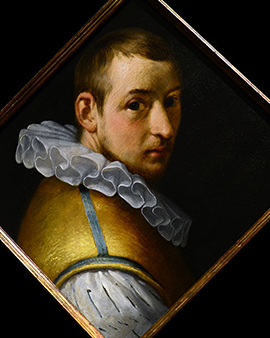


Cornelis Cornelisz van Haarlem was a renowned Dutch painter. His works are symbolic of Dutch mannerism. Mannerism is the general term for an art historical epoch that lasted from 1520 to 1600. The art style originated in Italy and quickly spread to other European countries. During these years, artists developed their very own, individual style. For this they used all the painting techniques at their disposal. Van Haarlem was born into this interesting art period. However, it was only after a tragic incident that he discovered the world of painting. In 1572 the citizens of Haarlem were driven from their homeland by Spanish troops. Haarlem was the birthplace of the painter. Corneli's parents also had to flee. Their ten-year-old son stayed behind. The Dutch Renaissance painter Pieter Pietersz took Cornelis in. He became his teacher. Peter introduced the boy to painting and inspired him to art.
At the age of 18 Cornelis van Haarlem leaves the house of his foster father Peter Pietersz. In the cities of Rouen and Antwerp he expands his painting skills before returning to his home town. He joins the school of Haarlem, which was mainly influenced by Bartholomaeus Spranger. Here Cornelis van Haarlem met his poet friend Karel van Mander and the talented engraver Hendrick Goltzius. Together, the three men discover mannerism for themselves.
During these years Cornelis van Haarlem developed his own art style. He loses himself in his passion for large-format nude painting. He draws naked bodies in often quite idiosyncratic poses, which, however, always had a decorative added value. Religious scenes from the Bible inspire him as much as mythological ones. He translates well-known scenes into his depiction of mannerism. For example, he painted the scene "Cave Parable of Plato". People love his works of art. His paintings are celebrated in exhibitions. Here he also met and fell in love with his later wife, Marietje Deyman, daughter of the mayor of Haarlem. Later his works of art become more naturalistic. The painter died at the age of 76 in his Dutch hometown Haarlem. The country still celebrates his works of art today. Among art connoisseurs van Haarlem is nicknamed "Dutch Michelangelo".

Cornelis Cornelisz van Haarlem was a renowned Dutch painter. His works are symbolic of Dutch mannerism. Mannerism is the general term for an art historical epoch that lasted from 1520 to 1600. The art style originated in Italy and quickly spread to other European countries. During these years, artists developed their very own, individual style. For this they used all the painting techniques at their disposal. Van Haarlem was born into this interesting art period. However, it was only after a tragic incident that he discovered the world of painting. In 1572 the citizens of Haarlem were driven from their homeland by Spanish troops. Haarlem was the birthplace of the painter. Corneli's parents also had to flee. Their ten-year-old son stayed behind. The Dutch Renaissance painter Pieter Pietersz took Cornelis in. He became his teacher. Peter introduced the boy to painting and inspired him to art.
At the age of 18 Cornelis van Haarlem leaves the house of his foster father Peter Pietersz. In the cities of Rouen and Antwerp he expands his painting skills before returning to his home town. He joins the school of Haarlem, which was mainly influenced by Bartholomaeus Spranger. Here Cornelis van Haarlem met his poet friend Karel van Mander and the talented engraver Hendrick Goltzius. Together, the three men discover mannerism for themselves.
During these years Cornelis van Haarlem developed his own art style. He loses himself in his passion for large-format nude painting. He draws naked bodies in often quite idiosyncratic poses, which, however, always had a decorative added value. Religious scenes from the Bible inspire him as much as mythological ones. He translates well-known scenes into his depiction of mannerism. For example, he painted the scene "Cave Parable of Plato". People love his works of art. His paintings are celebrated in exhibitions. Here he also met and fell in love with his later wife, Marietje Deyman, daughter of the mayor of Haarlem. Later his works of art become more naturalistic. The painter died at the age of 76 in his Dutch hometown Haarlem. The country still celebrates his works of art today. Among art connoisseurs van Haarlem is nicknamed "Dutch Michelangelo".
Page 1 / 1






